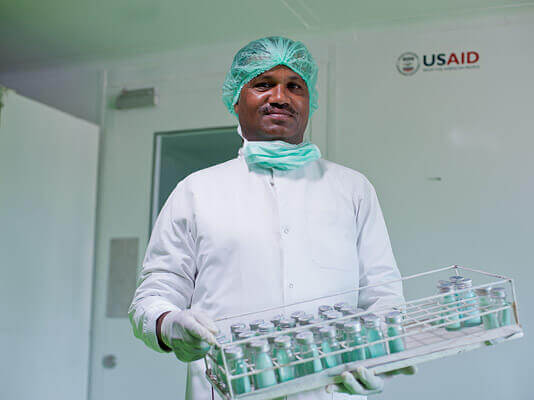Phil CarrollPATH
Phil Carroll is a senior policy communications associate at PATH, a global nonprofit dedicated to ending health inequity.
Phil Carroll is PATH’s Senior Policy Communications Associate. He spent two weeks in India last fall visiting PATH programs related to maternal and child health, tuberculosis, immunizations, and safe water and diarrheal disease.
India is a country that changes dramatically from place to place, something I experienced firsthand while on a two week trip there this past fall. One day I was listening in on a mothers’ group meeting in one of the poorest villages in Uttar Pradesh state, and less than 24 hours later I was standing in one of the world’s most technologically advanced airports in Hyderabad—often referred to as the ‘Silicon Valley’ of India. It was during this leg of my journey where I was further convinced of the need for sustained investment in research and development.
In a laboratory on the outskirts of the city, I met a handful of Indian doctors and researchers who are doing some pretty amazing, albeit subtle, things in health. Thanks to a small, less than $100,000, investment by the US Agency for International Development (USAID), the Blue Peter Public Health & Research Centre upgraded its tuberculosis (TB) lab to a higher level of biosafety. Improvements like better equipment and infrastructure and enhanced safety measures have enabled researchers here to diagnose a case of multi-drug resistant tuberculosis (MDR-TB) in a matter of days, a process that used to take the same team several months.

This is significant for a host of reasons. Diagnosing TB on the early side can help get patients on treatment faster, thereby reducing further deterioration of their lungs and other organs and ultimately save their lives. Catching TB early on can also curtail the spread of this incredibly contagious disease to others. India, which has the highest incidence of TB in the world, and 20 percent of the world’s burden, needs these sorts of advancements now more than ever. Currently, the government of India, as part of its National TB program, is only reaching 25 percent of MDR-TB patients with diagnosis. However, by 2013, it is aiming for 100 percent coverage, or around 2 million TB patients.
While this goal might appear daunting, it should hardly be seen as insurmountable. As evidenced by its incredible response to polio in the last few years, the Indian government—with the help of key partners like PATH—is capable of pulling off some amazing global health feats when it resolves to do so. The government of India, under its National TB Laboratory Scale-Up plan, is in the process of upgrading other labs like the Blue Peter Public Health & Research Centre lab throughout the country. PATH is helping to make these labs airborne infection control compliant, thereby reducing the spread of TB. This, combined with other TB-control interventions and sustained advocacy at the national level, has the promise to one day make this disease a distant memory for the people of India.
Look at the full “Fast TB diagnosis helps save lives in India” slideshow.